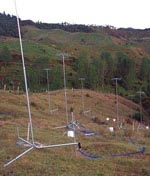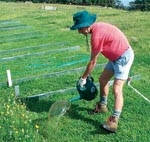PDF of this article (313 KB)

Rob Collins describes a series of field experiments that has helped to determine when and where riparian buffer strips can reduce faecal contamination of streams and lakes.
Faecal contamination of waterways poses a health risk to swimmers and can restrict shellfish aquaculture in estuaries. It can also be unhealthy for stock drinking the water. Droppings from grazing livestock can be an important source of microbes, including Campylobacter, Cryptosporidium oocysts, Giardia cysts, pathogenic E. coli, and Salmonellae. When rainfall is unable to soak down into the soil, these pathogens can be washed down grazed hillsides into waterways by surface runoff. One potential way to reduce the surface runoff of these microbes into streams is to plant riparian buffer strips – zones of dense vegetation running alongside a waterway that can trap the microbes washed down the hillslope.
So why not just plant riparian buffer strips along all waterways? This would be costly and would use up productive land. Besides, not much is known about just how important surface runoff is in transporting microbes. Nor is much known about how effective buffers are once microbes have been washed into them, or how entrapment might vary with factors such as slope angle and buffer width.
To address these questions, scientists from NIWA, AgResearch, Landcare Research, and Massey University have been working together on a series of field experiments funded by the Ministry of Agriculture and Forestry (MAF).
How important is surface runoff?

Our first task was to determine how important surface runoff is in transporting faecal microbes to streams. We set up two experiments, one in steep hill country, the other on relatively flat dairy land. At our hill-country site we used a large rainfall simulator to generate surface runoff on a hillside grazed by sheep. We measured the faecal bacteria indicator E. coli in the surface runoff as it flowed into a small headwater stream. Our results showed that surface runoff washed a substantial number of E. coli – between a million and a billion per square metre of hillside – into the stream during each simulated rainfall. We also found that the number of microbes decreased as the time since the hillside had last been grazed increased. During our simulator experiments, it was apparent that the velocity of surface runoff generated was so great that it was unlikely that a buffer strip could have trapped many of the E. coli. Fencing off stock from the numerous wetlands that characterise this steep hill country is more likely to reduce microbial contamination than planting buffer strips.
Our dairy farm experimental site was underlain by artificial subsurface drains to prevent waterlogging of the soil, a fairly common practice with dairy land. Water and microbes that flow via subsurface drains discharge to open ditches and, finally, to a larger waterway. This pathway bypasses the riparian zone, preventing any opportunity for microbes to be trapped in a buffer. Consequently, we wanted to determine just how much subsurface drainage there was compared to surface runoff. Sampling under both natural and simulated rainfall for E. coli and Campylobacter, we found that the artificial drains carried most flow and microbes. However, heavy intense rainfall did generate surface runoff and carried significant numbers of both microbes, suggesting that riparian buffers may be worthwhile on such land.
How effective are riparian buffers?

To determine how effective riparian buffers are at trapping microbes, we flushed dairy farm effluent down sloping grass plots by means of an irrigation system that generated surface runoff. The plots were 2 m wide and either 1 m or 5 m long and had a dense cover of long grass to represent a riparian buffer strip. We first measured the number of E. coli and Campylobacter in the effluent applied to the upper end of each plot, and again in the surface runoff discharging at the lower end of the plots. In this way we were able to determine just how many of those bacteria washed into the plot were trapped by the dense vegetation. Our results showed that entrapment decreased as the amount of surface runoff increased. This suggests that riparian buffer strips are less effective during prolonged, heavy rain. We also found that the shorter the length of the plot, the fewer microbes were trapped. Additionally, we found that entrapment can be temporary, since we were able to flush out some trapped microbes by generating more surface runoff a few days later. This ‘remobilisation’ reduces the effectiveness of a buffer.
Riparian guidelines
Using the results of our studies and others elsewhere around the world, we are drawing up a set of guidelines that will be available on the MAF website. The guidelines suggest how wide a riparian buffer strip should be to effectively trap faecal microbes, taking into account the influence of slope angle and soil type, and land-management practices such as artificial drainage. Additionally, our guidelines indicate where the use of riparian buffers may not be particularly effective or would have to be impractically wide to have any positive effect.
So, while there’s still plenty we don’t understand about how buffers work, this research has provided a good indication of just when and where riparian buffers can do an effective job of trapping faecal microbes.
Riparian buffers in brief
- Riparian buffer strips have been promoted as a way to protect waterways from contaminated runoff from paddocks.
- Surface runoff can flush millions of dangerous microbes.
- In steep hill country, buffer strips will not necessarily stop the flow of microbes.
- In flat dairy country, buffer strips may be worthwhile, especially during intense rainfall.
- Guidelines on creating effective riparian buffers will be available online.
Useful links
Technical papers about riparian buffers on MAF website
04/05 Review of riparian buffer zone effectiveness 03/07 Riparian attenuation of faecal microbes 02/16 Riparian attenuation of faecal microbes
National Centre for Water Resources: www.niwa.co.nz/ncwr
Dr Rob Collins is an ecosystem modeller based at NIWA in Hamilton. He is also the leader of NIWA’s National Centre for Water Resources.
This research was funded by the New Zealand Ministry of Agriculture and Forestry under the ‘Pathogen Transmission Routes’ research programme.
Teachers’ resource for NCEA AS: Biology 90168 (1.8), 90458 (2.2), 90483 (2.6); Geography 90207 (1.6), 90331 (2.1), 90336 (2.6); Science 90188 (1.3), 90313 (2.2) See other curriculum connections at www.niwa.co.nz/pubs/wa/resources
